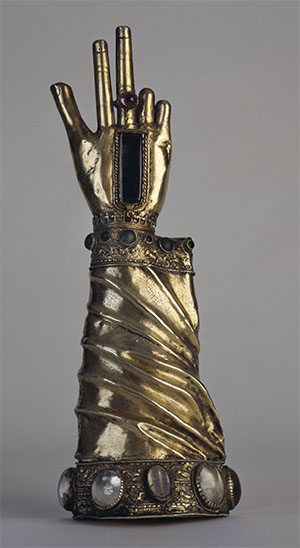The parish treasury boasts artefacts of international significance, chief among them a relic of St Patrick’s arm, enshrined in a priceless medieval silver reliquary. It also has a triptych altarpiece entitled ‘Madonna of the Lakes’ painted by Sir John Lavery, himself a celebrated son of the parish.
THE ARM SHRINE OF ST. PATRICK: The traditional belief regarding this shrine is that it dates back to the discovery of the relics of Sts. Patrick, Brigid and Colmcille in the Benedictine Cathedral of Downpatrick in 1186. The story is familiar to everyone how  some doubt having existed as to the exact whereabouts of the burial-place of these three saints and how in answer to prayer, the precise spot in the cathedral was revealed to Malachy III, Bishop of Down. In conjunction with John de Courcy, the bishop made application to Rome to have the bodies removed to some more fitting place in the cathedral, and such permission having been granted, a special legate, Cardinal Vivian, was sent over to Down to superintend the removal of the relics. The ceremony was carried out with great pomp, some of the relics were enshrined and placed on the high altar and some brought back to Rome. One of the enshrined relics was a bone from the arm of the national apostle. When Edward Bruce invaded Ireland he plundered the Cathedral of Down and the shrine was carried off in 1316.
some doubt having existed as to the exact whereabouts of the burial-place of these three saints and how in answer to prayer, the precise spot in the cathedral was revealed to Malachy III, Bishop of Down. In conjunction with John de Courcy, the bishop made application to Rome to have the bodies removed to some more fitting place in the cathedral, and such permission having been granted, a special legate, Cardinal Vivian, was sent over to Down to superintend the removal of the relics. The ceremony was carried out with great pomp, some of the relics were enshrined and placed on the high altar and some brought back to Rome. One of the enshrined relics was a bone from the arm of the national apostle. When Edward Bruce invaded Ireland he plundered the Cathedral of Down and the shrine was carried off in 1316.
Nothing further is heard of the shrine for some centuries, when it is found in the possession of the Magennis family of Iveagh, some of whom were Abbots and Bishops of Down. About 1710, one of this family married George Russell, of Rathmullan, County Down, and brought the relic with her. Rose Russell, their daughter, married Rowland Savage of the Ards and thus the shrine came into the possession of the Savages. The head of this family having become a Protestant and having changed his name to Nugent, did not care to have this shrine in his possession and handed it over to Rev. Teggart, parish priest of Portaferry. Fr Teggart having died in 1765, the shrine came into the possession of the McHenry family of Caristown in the Upper Ards in whose custody it remained until it was handed over to Dr Denvir, Bishop of Down and Connor. It has remained in the custody of the Bishop of Down and Connor since 1840.
The shrine is of silver and is a representation of the arm and hand of an ecclesiastical dignitary covered with an embroidered sleeve and a jewelled glove. It was originally decorated around the wrist and also at the elbow with a large number of precious stones whose colour and size added greatly to the beauty of the shrine and enhanced the skill of the workmanship. It measures just over one foot in length but unfortunately does not contain any date or inscription. The base of the shrine contains the letters IHS which are of some assistance towards dating it, as this sacred monogram does not seem to have come into use until the beginning of the 15th Century.
The presence of this sacred monogram of early 15th Century origin need not necessarily conflict with the above-mentioned tradition of the enshrining of the relic in the presence of John de Courcy and the Cardinal Legate Vivian. The inscription could easily have been incised on the shrine at a later date. Jewelled gloves are characteristic marks of ecclesiastical dignitaries in the Norman period. There is no ornamental decorative Celtic scroll-work such as we would expect about the period, and we are induced to conclude tentatively that the shrine is of English workmanship, and made around Downpatrick about 1200.
When the Shrine was opened by Dr Denvir, bishop of the diocese, in 1856, it contained no relic, but merely a piece of yew wood almost a foot long, with an aperture sufficiently large to receive the wrist bone of a human arm. This was smeared over at both ends with, apparently, wax seals which had been impressed on the inner wooden receptacle, possibly to keep the bone in position. The relic which the shrine had contained had apparently been worn away through constant use. It was customary for the keeper of the relic to pour water through the elbow termination of the shrine, which, touching the relic passing through, flowed out at the fingers and was used as a cure for various diseases. Indeed, one of the reasons why Col. Nugent did not wish to retain possession of the relic was on account of the numbers of people who came from all parts of the country seeking cures. The oaths might be taken by touching it in cases where disputes were being settled outside the courts of law.
In conclusion, it must be added that the shrine contains at present a genuine relic of St. Patrick. When Cardinal Vivian returned to Rome in 1186 he brought back to Pope Urban III some of the relics of St. Patrick, which were preserved in the Church of St. Mark in Rome. Dr Denvir made application for one of these, and Dr Dorrian had it inserted in the shrine, with the seal of the Cardinal Protector of the Church confirming the donation placed on the outside of the shrine.
The inscription is as follows:
Reliquae de Brachio St. Patritii Episcopi Iberniae Apostoli desumptae de Mandato Emi viri Petri S. R Eclae. Cardinalis de Silvestri Titularis S. Marci de Urbe
At present, the relic is preserved in the parish treasury while the priceless reliquary is on loan to and can be viewed at the Ulster Museum. On occasions of high solemnity, the two are reunited for veneration in the church.
LAVERY’S TRIPTYCH ALTARPIECE: on Sunday, 20th of April, 1919, Dr MacRory, Bishop of Down and Connor, unveiled in St. Patrick’s Church, the triptych altarpiece ‘The Madonna of the Lakes’, painted by a native of the parish, celebrated artist, Sir John Lavery.
Nearly two years previous, Fr John O’Neill, Administrator of St. Patrick’s, was asked to go to the presbytery’s reception room. There he met a small, rather stout and immaculately dressed man who gave his name as John Lavery.
Modestly and quietly, Sir John Lavery expressed his desire to present to the church of his Baptism, the first religious picture he had painted. It had been exhibited at the Royal Academy earlier that year. Before going to the presbytery, John had visited the church to select a suitably lit location for the painting. This, he suggested, would be the apse to the left of the church.
As Sir John rushed towards his taxi, waiting to take him to catch the boat-train to Stranraar, he promised to send a photograph of the painting, for those concerned, to study. Fr O’Neill walked with him to the taxi, where Lavery opened the door and introduced him to Hazel who had been waiting for him in the car. True to his word, John sent an enlarged photo but it would be a year and a half from that first visit to the unveiling of the triptych.
The initial place suggested for the triptych could not be made available because the donors of the original altar in that apse would not consent to its removal or relocation. Later it was placed in the apse on the left side of the church after a major fire gutted the church in 1995.
A total of ten handwritten letters from Sir John Lavery remain in the possession of the parish. There is also a typed letter from his secretary as well as one in Lady Lavery’s handwriting. These tell us much of the previously hidden detail of the painting’s story. The letters contain minutiae, giving his thoughts behind his religious painting as well as the arrangements for its placement in the church.
In Lavery’s letter of the 30th of December, 1917, he makes note of the involvement of Sir Edwin Lutyens in the design of the altar on which the triptych was to be placed. It is believed that Lutyens also designed the frame for the painting. After exhibition at other centres, the triptych was sent to Belfast. Unfortunately after it was dispatched, a railway strike took place and it was detained in England for several weeks. This was the cause of great anxiety on both sides of the Irish Sea and for some time the painting's location could not be determined. Eventually it arrived with the altar and its decorations and was installed for the unveiling on Easter Sunday, 1919.
One of the surviving artefacts which accompanied the triptych at that time was a letter from the art dealer valuing the painting for insurance purposes at £3,000.
The models for the triptych were the tree women in John Lavery’s life, his wife Hazel, his daughter, Eileen and his step-daughter Alice. St. Brigid, modelled on Eileen, later Lady Semphill, is surrounded by sheep, tradition believing Brigid to have been a shepherdess. St. Patrick, modelled on Alice, is depicted with pigs in the background recalling Patrick’s enslavement as a swineherd in County Antrim. Hazel was the model for the Madonna. She is depicted against an imagined backdrop of lakes and mountains.
In front of the triptych the visitor will notice a carved oak crucifix. This cross is modelled on the Celtic High Cross. The figure of Christ on the cross is unusual. He is wearing a crown and a kilt but the overall feeling portrayed is one of strength and courage. This cross was made for Lavery by Mr R May of Hopefield Avenue, near the Antrim Road. The wood used in the cross was a piece of oak salvaged from an old church in Ballinderry which was built from the remnants of an even older church which stood there in the late 1400s.
For further information on the life and works of Sir John Lavery, see a short publication written and produced by parish administrator, Fr Michael Sheehan, available from the parish office.

![Madonna of the Lakes Lavery[1]](https://saintpatricksbelfast.org.uk/wp-content/uploads/2015/09/Madonna-of-the-Lakes-Lavery1-300x196.jpg)